Tuscany : Hell ("Inferno")
In 1355 Nardo di Cione painted his depiction of Hell (Inferno)on the north wall of the Strozzi Chapel in the church of Santa Maria Novella. There were two major events in Florentine history, prior to the creation of Cione’s fresco, which ultimately shaped this representation. The first was the writing of the Divine Comedy by Dante Alighieri in the early 14th century, particularly the cantica entitled Inferno which inspired Cione’s overall composition of Hell. The second was the Black Death, a strain of the plague which swept across Europe in 1348 killing half the population of Florence. When the plague hit Dante had provided the Florentine people with the first truly detailed image of the journey which the soul takes after death, but it was the fear and uncertainty the Black Death fostered which gave them a greater purpose to depict the subject within the visual arts.
The work of Cione attempts a faithful illustration of the 34 cantos which comprise Inferno,with each small section of painting illuminating the corresponding literary text. Although badly damaged in the flood of 1967, the iconography of the piece still reflects Cione’s deep understanding of the complex tone Dante utilizes throughout The Divine Comedy. The text of Dante’s Inferno is particularly important when looking at the context in which the fresco was commissioned. The Church of Santa Maria Novella belonged to the Dominicans, a mendicant order who were famed for their strong intellectual and literary traditions. The Strozzi Chapel was commissioned by a Florentine family that had accumulated wealth and influence through both trade and banking. The Dominicans stressed confession and repentance, and Cione’s work exemplifies this concern shared by those members of the Strozzi family who had committed the sin of usury. A sin that according to Dante, will place you in the inner circle of the seventh circle of hell. Cione’s work expresses the fear which the Inferno imparted on its readers and the role which art played to help quell those fears. A work that ultimately allowed the Dominicans to assert their presence within the church and reinforce the ideology behind their faith.

